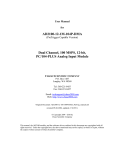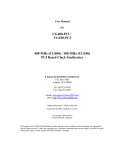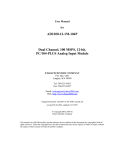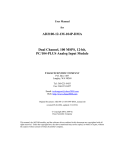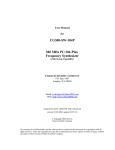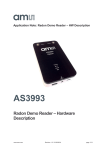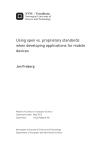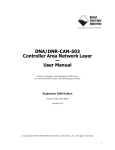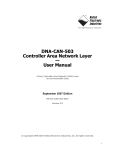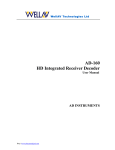Download User`s Manual V1 - Chase Scientific Company
Transcript
User Manual for AD160-12-8M-104 Single Channel, 60 MSPS, 12-bit, PC/104 Analog Input Module CHASE SCIENTIFIC COMPANY P.O. Box 1487 Langley, WA 98260 Tel: 360-221-8455 Fax: 360-221-8457 Email: [email protected] Web: http://www.chase2000.com Original Document: AD160-12-8M-104_manual.odt (created 10-23-2006, updated 4/5/2007) Copyright 2006 by Chase Scientific Company This manual, the AD160 module, and the software drivers outlined in this document are copyrighted with all rights reserved. Under the copyright laws, the above mentioned may not be copied, in whole or in part, without the express written consent of Chase Scientific Company. AD160 User Manual 60 MSPS, PC/104 ANALOG INPUT MODULE TABLE OF CONTENTS 1 GENERAL INFORMATION...........................................................................................................................4 1.1 INTRODUCTION..................................................................................................................................................4 1.2 REFERENCES.................................................................................................................................................... 4 1.3 DELIVERABLES................................................................................................................................................. 4 1.3.1 Software................................................................................................................................................ 4 1.3.2 Hardware.............................................................................................................................................. 5 1.3.3 Checklist................................................................................................................................................5 1.4 PRODUCT SPECIFICATION....................................................................................................................................5 1.5 TECHNICAL SUPPORT / SOFTWARE UPDATES......................................................................................................... 6 1.6 WARRANTY..................................................................................................................................................... 6 2 HARDWARE DESCRIPTION........................................................................................................................ 7 2.1 INTRODUCTION..................................................................................................................................................7 2.2 BLOCK DIAGRAM..............................................................................................................................................7 2.3 BOARD DRAWING............................................................................................................................................. 8 2.4 BOARD I/O..................................................................................................................................................... 9 2.4.1 Header Pinouts and Pin Descriptions.................................................................................................. 9 2.5 HARDWARE REGISTER DEFINITIONS..................................................................................................................... 9 2.6 ANALOG INPUT RANGES AND RESOLUTION........................................................................................................... 9 3 THEORY OF OPERATION.......................................................................................................................... 10 3.1 INTRODUCTION................................................................................................................................................10 3.2 ACQUIRING ANALOG INPUT DATA.....................................................................................................................10 4SOFTWARE DRIVERS.................................................................................................................................. 10 4.1 INTRODUCTION................................................................................................................................................10 4.2 DRIVER INSTALLATION.....................................................................................................................................10 4.2.1 16-Bit DOS..........................................................................................................................................10 4.2.2 Linux Installation (Kernels 2.2x, 2.4x, 2.6x).......................................................................................10 4.2.3Windows 98/ME/2000/XP.................................................................................................................... 11 4.3 FUNCTION CALLS............................................................................................................................................11 4.3.1 Function Declarations in C................................................................................................................ 11 4.3.2 Function Call Descriptions / Usage................................................................................................... 13 4.3.2.1 ad160_SetBasePortAddr().............................................................................................................................. 13 4.3.2.2 ad160_Reset()................................................................................................................................................. 13 4.3.2.3 ad160_SetClockRate()....................................................................................................................................14 4.3.2.4 ad160_Set_Memory_Size()............................................................................................................................ 14 4.3.2.5 SetTrigPol().................................................................................................................................................... 15 4.3.2.6 ad160_Digitize()............................................................................................................................................. 15 4.3.2.7 ad160_DIG_DONE()......................................................................................................................................16 4.3.2.8 ad160_Transfer_Data()...................................................................................................................................16 4.3.2.9 ad160_PowerDown()......................................................................................................................................17 4.4PROGRAMMING EXAMPLES................................................................................................................................ 17 4.4.1 DOS 16-BIT C Example......................................................................................................................17 4.4.2LINUX C/C++ Example..................................................................................................................... 19 5MISCELLANEOUS......................................................................................................................................... 21 5.1CALIBRATION.................................................................................................................................................. 21 5.2MAINTENANCE................................................................................................................................................ 21 © Chase Scientific Company (360)221-8455 2 AD160 User Manual 60 MSPS, PC/104 ANALOG INPUT MODULE ILLUSTRATIONS / TABLES FIGURE 1 – BLOCK DIAGRAM...................................................................................................................... 8 FIGURE 2 – BOARD LAYOUT......................................................................................................................... 9 FIGURE 3 - 4-PIN DIGITAL I/O CONNECTOR.......................................................................................... 10 © Chase Scientific Company (360) 221-8455 3 AD160 User Manual 1 60 MSPS, PC/104 ANALOG INPUT MODULE GENERAL INFORMATION 1.1 Introduction The AD160-12-8M-104 is a PC/104 analog I/O module which features one (1) 12-bit, high speed singledended (50 ohms) analog input channel capable of capturing data at up to 60 MSPS with a minimum bandwidth of 20 Mhz (100 Mhz optional). The AD160 module also comes standard with power down capability and operates over industrial temperature range standard (40°C to 85°C). The analog input and trigger inputs are available on SMA connectors. The Analog input has up to 8Meg of software selectable onboard memory. The trigger source can be either an external TTL trigger or on-board software trigger. Timing is controlled by an onboard clock circuit referenced to a 60 MHz crystal oscillator and can be programmed for 60MHz, 30MHz, 15MHz, and 7.5MHz. Once A/D conversions are completed, data can be transferred from the module to main memory via I/O port reads using simple function calls. 1.2 References “P996.1 Standard for Compact Embedded-PC Modules”; PC/104 Specification, Version 2.3, June 1996 by PC/104 Consortium. “IEEE P996 draft standard”, 1987 by IEEE Standards Committee. This bus standard was the basis for the first PC/104 standard released in 1992. 1.3 1.3.1 Deliverables Software The AD160 comes with source code drivers for 16-bit DOS and 32-bit Linux. Software comes on a single 3.5” diskette or Mini-CD. Call Chase Scientific for the latest information on drivers for other operating system platforms or check the web site for the latest updates. Software drivers are provided as source code in DOS 16-bit Borland C++ 5.2 code and Linux GNU GCC Version 4.1.0. Actual Listing of files on Diskette/CD for Windows: ----------- D I R E C T O R I E S / F I L E S ---------------- AD160_Drivers (BASE_DIR) | | readme.txt // This file. | AD160-12-8M-104_manual.pdf // Manual | | DOS_6p22 // Directory for 16-Bit Borland C Drivers | | AD160drv.c // AD160 Driver Source | | AD160DRV.H // AD160 Driver Header | | AD160_EX.C // AD160 Example Source (calls driver) | | AD160.EXE // AD160 Compiled Example (uses Free Borland Turbo C 2.02) | | LINUX_FC-5_2.6.15 // Directory for GNU GCC Version 4.1.0 | | ad160drv_o.cpp // AD160 Driver Source © Chase Scientific Company (360)221-8455 4 AD160 User Manual | | ad160drv_o.H | | ad160_test.cpp | | ad160_test | | makefile "ad160_test". -------------- 1.3.2 60 MSPS, PC/104 ANALOG INPUT MODULE // // // // E N D AD160 Driver Header AD160 Example Source (calls driver) Example of Executable Compiled on Fedora Core 5. Type "makefile" to Compile Example code into Executable ---------------- Hardware The AD160 hardware consists of a single PC/104 compliant module. The module is shipped with a manual with complete hardware and software descriptions. The ISA bus connector (PC/104 only portion) is the only connector on the card. There is no active or passive pass through PC/104-Plus connector. 1.3.3 Checklist Item # Qty 1 1 AD160-12-8M-104 Single Channel 60 MSPS, 12-bit, A/D PC/104 Module 2 1 AD160-Drivers 3.5” diskette with 16-Bit DOS source code and 32-Bit Linux source code. Includes examples. 3 1 AD160-Manual User manual for AD160 board and software drivers. 1.4 Part Number Description Product Specification (all specifications are at 25C unless otherwise specified) HIGH SPEED ANALOG INPUTS (CH1-2) (1) Synchronous, Single Ended into 50 ohms Number of inputs A/D Resolution 12-bit (1 part in 4096) Input Bandwidth 20 MHz minimum @ 1V pk to pk Input Range The A/D count of 0 equals -0.525V. A count of 4095 equals +0.525V. (order option 3 for user specified FIXED gain) Acquisition Time to Full-Scale Step 16 ns typical to 0.01% (1/2 LSB) Input Coupling 50 ohms load to ground/shield Overvoltage Protection +/- 6V Maximum Nonlinearity +/- 2 LSB typical Memory Size 8048576 samples maximum, 1048576 standard Segment Sizes Software selectable memory sizes of 128, 256, ... , 8048576 in multiples of 2. Acquisition Mode Single-shot initiated by software, external or internal triggering (see trigger sources) Timebase 60 MHz, 30 MHz, 15 MHz, 7.5 Mhz (Software Selectable) Trigger Location Fixed trigger position at beginning of each segment Sources external TTL signal, internal software trigger Slope Positive, Negative Coupling DC GENERAL Power Supply (Vcc) Operating Temperature Operating Humidity Size Data Bus © Chase Scientific Company +5V @ 410mA (Ave. Running) +5V @ 130mA (PWR_DWN) -40 to +85 degrees C standard 5 to 95% non-condensing PC/104: 3.55" x 3.775" 16-bits PC/104 (i.e. ISA) (360) 221-8455 5 AD160 User Manual 1.5 60 MSPS, PC/104 ANALOG INPUT MODULE Technical Support / Software Updates For technical support: Phone Fax Email Mail (360) 221-8455 (360) 221-8457 [email protected] Chase Scientific Company P.O. Box 1487 Langley, WA 98260 For software updates: Email Web 1.6 [email protected] http://www.chase2000.com Warranty Chase Scientific Company (hereafter called Chase Scientific) warrants to the original purchaser that its AD160-12-1M-104P, and the component parts thereof, will be free from defects in workmanship and materials for a period of ONE YEAR from the data of purchase. Chase Scientific will, without charge, repair or replace at its option, defective or component parts upon delivery to Chase Scientific’s service department within the warranty period accompanied by proof of purchase date in the form of a sales receipt. EXCLUSIONS: This warranty does not apply in the event of misuse or abuse of the product or as a result of unauthorized alterations or repairs. It is void if the serial number is altered, defaced or removed. Chase Scientific shall not be liable for any consequential damages, including without limitation damages resulting from loss of use. Some states do not allow limitation or incidental or consequential damages, so the above limitation or exclusion may not apply to you. This warranty gives you specific rights. You may also have other rights that vary from state to state. Chase Scientific warrants products sold only in the USA and Canada. In countries other than the USA, each distributor warrants the Chase Scientific products that it sells. NOTICE: Chase Scientific reserves the right to make changes and/or improvements in the product(s) described in this manual at any time without notice. © Chase Scientific Company (360)221-8455 6 AD160 User Manual 2 60 MSPS, PC/104 ANALOG INPUT MODULE HARDWARE DESCRIPTION 2.1 Introduction The AD160 hardware consists of the following major functions: • (1) 12-bit, 60 MSPS synchronous, single-ended, bipolar A/D Inputs (DC coupled) • (1) TTL Trigger Input 2.2 Block Diagram Figure 1 – Block Diagram © Chase Scientific Company (360) 221-8455 7 AD160 User Manual 2.3 60 MSPS, PC/104 ANALOG INPUT MODULE Board Drawing TTL Trigger input Analog Input Figure 2 – Board Layout © Chase Scientific Company (360)221-8455 8 AD160 User Manual 2.4 2.4.1 60 MSPS, PC/104 ANALOG INPUT MODULE Board I/O Header Pinouts and Pin Descriptions N/A 2.5 Hardware Register Definitions Due to hardware protocol complexity, the details on how to use these ports are beyond the scope of this manual. The software drivers should provide an effortless integration path for the user. However, if the need arises that is beyond what the software drivers can provide, please call the factory for technical support. 2.6 Analog Input Ranges and Resolution Analog input range is by default +/- 0.528V. Consult factory for user gain setting options. The resolution is 12 bits. © Chase Scientific Company (360) 221-8455 9 AD160 User Manual 3 60 MSPS, PC/104 ANALOG INPUT MODULE THEORY OF OPERATION 3.1 Introduction Because the PC/104 bus is significantly slower than the digitizing rate of the AD160, the data must first be digitized and stored on the AD160 and then transferred to system memory at the slower bus speed. 3.2 Acquiring Analog Input Data Before capturing data, the user must first setup the correct digitizing rate, determine if they're going to use external or internal trigger mode, and trigger polarity. After proper setup is performed, you’re ready to digitize. When the digitize function is called, the A/D converter is then activated after the first trigger event and the digitized analog signal is stored into buffer RAM. Data is then transferred to system RAM using another function call. IMPORTANT: The RAM on the AD160 is designed so that every time a sample is read out, an on-board address counter is automatically incremented. What this means is that if the user is limited in how much data they can read out at a given time - due to 16-bit DOS for example - then the user can read the samples out in 16K bursts and then store the data in another location such as a solid state disk drive or specially configured memory. 4 SOFTWARE DRIVERS 4.1 Introduction The primary objective in designing software drivers is to get the user up and running as quickly as possible. The details on installing software drivers are listed in 4.2.xx. While the listing of function calls and their parameter definitions are listed in section 4.3.xx, the programming examples in section 4.4.x will show you how to include them into your programs. The driver source codes are designed to work under all versions of 16-bit DOS and Linux with Kernel Code versions 2.2.x through 2.6.x. 4.2 4.2.1 Driver Installation 16-Bit DOS DOS drivers are much simpler to use than Windows drivers, especially if they are not RAM resident types like they are in this case. Just include (i.e. “#include "ad160drv.c"”) in your program and you're done. See sample code “ad160_example.cpp” for more information. 4.2.2 Linux Installation (Kernels 2.2x, 2.4x, 2.6x) © Chase Scientific Company (360)221-8455 10 AD160 User Manual 60 MSPS, PC/104 ANALOG INPUT MODULE The Linux source driver code is almost as easy to use as the DOS driver code. We have provided a make file and example user code for your convenience so that you have a place to start. Please study the example file “ad160_test.cpp” thoroughly. 4.2.3 Windows 98/ME/2000/XP Not applicable at this time. 4.3 Function Calls 4.3.1 Function Declarations in C DOS HEADER FILE /* /* /* /* /* /* /* /* /* /* /* */ AD160 Header File for 16-Bit Borland Turbo C 2.02 */ ================================================= */ */ Filename: ad160drv.h */ */ Web site: http://www.chase2000.com */ Email: [email protected] */ */ (c) Chase Scientific 2006 */ */ #ifndef ad160drvH #define ad160drvH typedef typedef typedef typedef unsigned char BYTE; unsigned short WORD; unsigned long DWORD; void *PVOID; DWORD Memory_Size; WORD BasePortAddr = 0x240; /* DEFAULT BASE PORT ADDRESS - Change as needed */ /***** USER ROUTINES ***********************************************/ void ad160_SetBasePortAddr(WORD PortAddr); /* AD160 default = 0x240 */ void ad160_Reset(void); void ad160_SetClockRate(BYTE CLK_SEL); /* 1-4 ==> 60,30,15,7.5 MHz */ void ad160_Set_Memory_Size(BYTE MemSize); /* SEE BELOW FOR SIZES */ void SetTrigPol(BYTE TrigPol); void ad160_Digitize(BYTE UseExtTrig); BYTE ad160_DIG_DONE(void); BYTE ad160_Transfer_Data(PVOID UserArray,DWORD NumSamples); void ad160_PowerDown(BYTE PwrDwn); /* if if if if (MemSize (MemSize (MemSize (MemSize == == == == 4) 5) 6) 7) © Chase Scientific Company Memory_Size Memory_Size Memory_Size Memory_Size = = = = 16; 32; 64; 128; (360) 221-8455 11 AD160 User Manual */ 60 MSPS, PC/104 ANALOG INPUT MODULE if if if if if if if (MemSize (MemSize (MemSize (MemSize (MemSize (MemSize (MemSize == == == == == == == 8) 9) 10) 11) 12) 13) 14) Memory_Size Memory_Size Memory_Size Memory_Size Memory_Size Memory_Size Memory_Size = = = = = = = 256; 512; 1024; 2048; 4096; 8192; 16384; if if if if if if if if if (MemSize (MemSize (MemSize (MemSize (MemSize (MemSize (MemSize (MemSize (MemSize == == == == == == == == == 15) 16) 17) 18) 19) 20) 21) 22) 23) Memory_Size Memory_Size Memory_Size Memory_Size Memory_Size Memory_Size Memory_Size Memory_Size Memory_Size = = = = = = = = = 32768; 65536; 131072; 262144; 524288; 1048576; 2097152; 4194304; 8388608; #endif LINUX HEADER FILE //--------------------------------------------------------------------------// Filename: ad160drv_o.H //--------------------------------------------------------------------------// // 6-10-2006 Debug on Fedora 5 (Linux Version 2.6.15) // - Downloaded 3/20/06 // //--------------------------------------------------------------------------// Web site: http://www.chase2000.com // Email: [email protected] // // (c) Chase Scientific 2006 // //--------------------------------------------------------------------------//--------------------------------------------------------------------------#ifndef _ad160drv_O_H #define _ad160drv_O_H typedef typedef typedef typedef unsigned char BYTE; unsigned short WORD; unsigned long DWORD; void *PVOID; /***** USER ROUTINES ***********************************************/ void ad160_SetBasePortAddr(WORD PortAddr); // AD160 default = 0x240 void ad160_Reset(void); void ad160_SetClockRate(BYTE CLK_SEL); // 0-3 ==> 60,30,15,7.5 MHz void ad160_Set_Memory_Size(BYTE MemSize); // SEE BELOW FOR SIZES void SetTrigPol(BYTE TrigPol); void ad160_Digitize(BYTE UseExtTrig); BYTE ad160_DIG_DONE(void); BYTE ad160_Transfer_Data(PVOID UserArray,DWORD NumSamples); void ad160_PowerDown(BYTE PwrDwn); /* © Chase Scientific Company (360)221-8455 12 AD160 User Manual */ if if if if if if if if if if if if if if if if if if if if (MemSize (MemSize (MemSize (MemSize (MemSize (MemSize (MemSize (MemSize (MemSize (MemSize (MemSize (MemSize (MemSize (MemSize (MemSize (MemSize (MemSize (MemSize (MemSize (MemSize == == == == == == == == == == == == == == == == == == == == 60 MSPS, PC/104 ANALOG INPUT MODULE 4) 5) 6) 7) 8) 9) 10) 11) 12) 13) 14) 15) 16) 17) 18) 19) 20) 21) 22) 23) Memory_Size Memory_Size Memory_Size Memory_Size Memory_Size Memory_Size Memory_Size Memory_Size Memory_Size Memory_Size Memory_Size Memory_Size Memory_Size Memory_Size Memory_Size Memory_Size Memory_Size Memory_Size Memory_Size Memory_Size = = = = = = = = = = = = = = = = = = = = 16; 32; 64; 128; 256; 512; 1024; 2048; 4096; 8192; 16384; 32768; 65536; 131072; 262144; 524288; 1048576; 2097152; 4194304; 8388608; #endif 4.3.2 Function Call Descriptions / Usage 4.3.2.1 ad160_SetBasePortAddr() Description Sets the base I/O port address which the remaining function calls use. The AD160 card has a default value of 0x240 as the base address. At the time of the this writing, the base address can only be programmed at the factory. Declaration void ad160_SetBasePortAddr(WORD PortAddr); // AD160 default = 0x240 Parameters PortAddr: Hex Value 0x240 only. Return Value None. Example ad160_SetBasePortAddr(0x240); 4.3.2.2 ad160_Reset() Description Activates a master hardware reset function on the AD160. This primarily returns the card to a ready state by resetting the memory counters and triggering functions (re-arms). This should be called immediately after opening card for the first time and every time before "ad160_Digitize" is called. This function call does not effect Trigger Polarity, Memory Size, or Clock Rate previously set using other function calls. Declaration void ad160_Reset(void); © Chase Scientific Company (360) 221-8455 13 AD160 User Manual 60 MSPS, PC/104 ANALOG INPUT MODULE Parameters None. Return Value None. Example ad160_Reset(); // Resets card before ad160_Digitize() is called. 4.3.2.3 ad160_SetClockRate() Description Closes AD160 drivers. Should be called after finishing using the driver. However, if no other software uses the “windrv.xxx” (usual situation), then there is no need to close it until user is ready to completely exit from using their main software program. Declaration void ad160_SetClockRate(BYTE CLK_SEL); // 0-3 ==> 60,30,15,7.5 MHz Parameters CLK_SEL: 0 <= CLK_SEL <= 3 where 0, 1, 2, 3 ==> 60, 30, 15, 7.5 MHz Return Value None. Example ad160_SetClockRate(1); // Set clock rate to 60 Mhz. 4.3.2.4 ad160_Set_Memory_Size() Description Sets the exact size of memory that the card will use while digitizing. Declaration void ad160_Set_Memory_Size(BYTE MemSize); Parameters MemSize: /* if if if if if if if if if if if 4 <= MemSize <= 23 (MemSize (MemSize (MemSize (MemSize (MemSize (MemSize (MemSize (MemSize (MemSize (MemSize (MemSize == == == == == == == == == == == 4) 5) 6) 7) 8) 9) 10) 11) 12) 13) 14) © Chase Scientific Company Memory_Size Memory_Size Memory_Size Memory_Size Memory_Size Memory_Size Memory_Size Memory_Size Memory_Size Memory_Size Memory_Size = = = = = = = = = = = 16; 32; 64; 128; 256; 512; 1024; 2048; 4096; 8192; 16384; (360)221-8455 14 AD160 User Manual */ if if if if if if if if if (MemSize (MemSize (MemSize (MemSize (MemSize (MemSize (MemSize (MemSize (MemSize 60 MSPS, PC/104 ANALOG INPUT MODULE == == == == == == == == == 15) 16) 17) 18) 19) 20) 21) 22) 23) Memory_Size Memory_Size Memory_Size Memory_Size Memory_Size Memory_Size Memory_Size Memory_Size Memory_Size = = = = = = = = = 32768; 65536; 131072; 262144; 524288; 1048576; 2097152; 4194304; 8388608; Return Value None. Example ad160_Set_Memory_Size(23); // Sets memory size to 8M 4.3.2.5 SetTrigPol() Description Sets the edge polarity of the external trigger. Declaration void SetTrigPol(BYTE TrigPol); Parameters TrigPol: 0: Positive Edge Triggered. 1: Negative Edge Triggered. Return Value None. Example SetTrigPol(0); // Set trigger to Positive Edge Triggered mode. 4.3.2.6 ad160_Digitize() Description Sets the segment size. If NumSegments (see "ad160_SetNumSegments" ) is set to 1, you can use all segment sizes listed below. If using multiple segments (more than 1 segment), then you can only use SegSize: 0 <= SegSize <= 5. Declaration void ad160_Digitize(BYTE UseExtTrig); Parameters UseExtTrig: 0: Uses automatic internal trigger mode. 1: Waits for external trigger to occur before digitizing. © Chase Scientific Company (360) 221-8455 15 AD160 User Manual 60 MSPS, PC/104 ANALOG INPUT MODULE Return Value None. Example ad160_Digitize(0); // Immediately starts digitizing 4.3.2.7 ad160_DIG_DONE() Description Returns a “1” value if digitizing is complete, otherwise a “0”. Used as a polling device instead of interrupt for delaying until digitizing is complete before transferring data to system memory. Declaration BYTE ad160_DIG_DONE(void); Parameters None. Return Value BrdNum: 1 <= CardNum <= 4 0: Digitizing NOT DONE yet 1: Digitizing complete Example i = 0; while (!ad160_DIG_DONE()) { i = i+1; if (i > 1000000) break; // Delay until digitizing is done. 4.3.2.8 ad160_Transfer_Data() Description Called after “ad160_DIG_DONE” has come back true to transfer data from card to system memory. The user can call any number of samples up to that previously set by “ad160_Set_Memory_Size()”. This function called be called any number of times as long as the total number does not exceed that set by “ad160_Set_Memory_Size()”. Declaration BYTE ad160_Transfer_Data(PVOID UserArray,DWORD NumSamples); Parameters UserArray: Pointer to one dimensional array defined by user. NumSamples: Any number of samples up to Memory Size previously set. Return Value 0: Everything is ok. 1: Digitizing did not complete Example ad160_Transfer_Data(UserArray, 1024); © Chase Scientific Company // Moves 1024 samples to UserArray. (360)221-8455 16 AD160 User Manual 60 MSPS, PC/104 ANALOG INPUT MODULE 4.3.2.9 ad160_PowerDown() Description Places AD160 in the lowest possible power state. AD160 must be powered up for TBD microseconds before digitizing. Declaration void ad160_PowerDown(BYTE PwrDwn); Parameters PwrDwn: 0: Board is Powered “ON” and ready for digitizing 1: Forces board into a Powered “OFF” state. Cannot digitize in this state. Return Value None. Example ad160_PowerDown(1); 4.4 Programming Examples 4.4.1 /* /* /* /* /* /* /* /* /* /* /* /* /* // Puts AD160 card into a low power state. DOS 16-BIT C Example */ AD160 Sample File - Calls "ad160drv.c" */ ================================================= */ */ 16-Bit DOS Application (tested on MSDOS 6.22) */ */ Filename: ad160_example.c */ */ Web site: http://www.chase2000.com */ Email: [email protected] */ */ (c) Chase Scientific 2006 */ */ #include #include #include #include #include #include #include <dos.h> <stdio.h> <stdlib.h> <string.h> <conio.h> <alloc.h> <math.h> #include "ad160drv.c" /* Actual driver routines for AD160 */ typedef WORD *Array; Array DataArray; /* One Dimensional Array, 16-bit unsigned */ /*********************************************************************/ main () { /*--------------------------------------------------------------------*/ © Chase Scientific Company (360) 221-8455 17 AD160 User Manual 60 MSPS, PC/104 ANALOG INPUT MODULE /* 1) INITIALIZE VARIABLES, ALLOCATE MEMORY */ /*--------------------------------------------------------------------*/ unsigned long i; FILE *fout1; /* Allocate memory for dynamic variable DataArray. See ad160drv.h /* for declaration of DataArray. if ((DataArray = (Array) calloc(1024,sizeof(WORD *))) == NULL) { printf( "Not Enough Memory\n" ) ; exit(1) ; } */ */ fout1 = fopen("data1.dat", "w") ; /*--------------------------------------------------------------------*/ /* 2) SETUP CARD */ /*--------------------------------------------------------------------*/ ad160_SetBasePortAddr(0x240); printf("Set BasePortAddr. \n") ; printf("CTRL_PORT(read) = %x\n\n", inportb(CTRL_PORT) ) ; ad160_Reset(); /* Resets Key Control Bits */ printf("Reset. \n") ; printf("CTRL_PORT(read) = %x\n\n", inportb(CTRL_PORT) ) ; ad160_PowerDown(0); /* Power Up Card */ printf("De-Activate PWR_DWN. \n") ; printf("CTRL_PORT(read) = %x\n\n", inportb(CTRL_PORT) ) ; ad160_SetClockRate(1); /* Set Clock to 60 MHz */ printf("SetClockRate to 60 MHz. \n") ; printf("CTRL_PORT(read) = %x\n\n", inportb(CTRL_PORT) ) ; ad160_Set_Memory_Size(10); /* Set Memory Size to 1024 Samples */ printf("Set Memory Size to 1024 Samples. \n") ; printf("SEG_PORT(read) = %x\n\n", inportb(SEG_PORT) ) ; SetTrigPol(0); printf("Set Trigger Polarity. \n") ; printf("CTRL_PORT(read) = %x\n\n", inportb(CTRL_PORT) ) ; /*--------------------------------------------------------------------*/ /* 3) DIGITIZE / WAIT FOR DONE */ /*--------------------------------------------------------------------*/ ad160_Digitize(0); printf("Start Digitize. \n") ; printf("CTRL_PORT(read) = %x\n\n", inportb(CTRL_PORT) ) ; printf("Waiting for PostTriggering to Complete ... \n") ; i = 0; while (!ad160_DIG_DONE()) { i = i+1; if (i > 10000) break; } printf("DIG_DONE = 1! \n") ; printf("Polling Iterations = %d\n\n",i); /*--------------------------------------------------------------------*/ /* 4) TRANSFER DATA FROM AD160 SRAM TO "DataArray" */ /*--------------------------------------------------------------------*/ printf("Transfer Data from Board to System Memory. \n") ; ad160_Transfer_Data(DataArray,Memory_Size); /* Manually transfers data from CH1 buffer */ /* printf("CTRL_PORT(read) = %x\n\n", inportb(CTRL_PORT) ) ; */ ad160_Reset(); /* Resets Key Control Bits */ printf("Reset. \n") ; printf("CTRL_PORT(read) = %x\n\n", inportb(CTRL_PORT) ) ; © Chase Scientific Company (360)221-8455 18 AD160 User Manual 60 MSPS, PC/104 ANALOG INPUT MODULE /*--------------------------------------------------------------------*/ /* 5) WRITE CH1 DATA TO FILE "Data1.dat" */ /*--------------------------------------------------------------------*/ printf("Writing CH1 Data from Memory to Files Data1.dat \n") ; for ( i = 0; i < (Memory_Size-1); i++) /* Memory_Size; i++ ) */ { /* printf( "%d\n", (DataArray[i] & 0x0FFF) ) ; */ fprintf( fout1, "%d\n", (DataArray[i] & 0x0FFF) ); } printf("Writing Complete. \n\n") ; printf("CTRL_PORT(read) = %x\n", inportb(CTRL_PORT) ) ; fprintf( fout1, "%d\n", inportb(CTRL_PORT) ); /*--------------------------------------------------------------------*/ /* 6) FREE "DataArray" Memory, CLOSE FILE fout1 (="Data1.dat") */ /*--------------------------------------------------------------------*/ free(DataArray); fclose( fout1 ) ; return (0); } 4.4.2 LINUX C/C++ Example //--------------------------------------------------------------------------// Filename: ad160_test.c //--------------------------------------------------------------------------// // 6-10-2006 Debug on Fedora 5 (Linux Version 2.6.15) // - Downloaded 3/20/06 // //--------------------------------------------------------------------------// Web site: http://www.chase2000.com // Email: [email protected] // // (c) Chase Scientific 2006 // //--------------------------------------------------------------------------//--------------------------------------------------------------------------#include #include #include #include #include #include <stdio.h> <stdlib.h> <alloc.h> <string.h> <math.h> <asm/io.h> //<sys/io.h> #include "ad160drv_o.H" // Supersedes "asm/io.h" // Actual driver routines for AD160 /*********************************************************************/ int main() { //(int argc, char *argv[]) //-------------------------------------------------------------------// 1) INITIALIZE VARIABLES //-------------------------------------------------------------------typedef WORD *Array; Array DataArray; © Chase Scientific Company // One Dimensional Array, 16-bit unsigned (360) 221-8455 19 AD160 User Manual 60 MSPS, PC/104 ANALOG INPUT MODULE unsigned long MemorySize; int i; FILE *fout1; fout1 = fopen("data1.txt", "w") ; //-------------------------------------------------------------------// 2) SETUP CARD //-------------------------------------------------------------------ad160_SetBasePortAddr(0x240); printf("Set BasePortAddr. \n") ; printf("CTRL_PORT(read) = %x\n\n", inb(0x240) ) ; ad160_Reset(); // // // // // Resets Key Control Bits printf("Reset. \n") ; printf("CTRL_PORT(read) = %x\n\n", inb(0x240) ) ; ad160_PowerDown(1); // Power Down Card Test (activate PWRDWN) printf("Activate PWR_DWN (high). \n") ; printf("CTRL_PORT(read) = %x\n\n", inb(0x240) ) ; // and return return (0); ad160_PowerDown(0); // Power Up Card (deactivate PWRDWN) printf("De-Activate PWR_DWN. \n") ; printf("CTRL_PORT(read) = %x\n\n", inb(0x240) ) ; ad160_SetClockRate(1); // Set Clock to 7.5 MHz 1=60, 2=30, 3=15, 4=7.5 printf("SetClockRate to 7.5MHz. \n") ; printf("CTRL_PORT(read) = %x\n\n", inb(0x240) ) ; ad160_Set_Memory_Size(17); // Set Memory Size to 128K MemorySize = 131072; // ad160_Set_Memory_Size(23); // Set Memory Size to 128K // MemorySize = 8388608; // ad160_Set_Memory_Size(10); // Set Memory Size to 128K // MemorySize = 1024; printf("Set Memory Size to 8M Samples. \n") ; printf("SEG_PORT(read) = %x\n\n", inb(0x241) ) ; //-------------------------------------------------------------------// 3) ALLOCATE MEMORY FOR "DataArray" //-------------------------------------------------------------------if ((DataArray = (Array) calloc(MemorySize,sizeof(WORD *))) == NULL) { printf( "Not Enough Memory\n" ) ; exit(1) ; } //-------------------------------------------------------------------// 4) DIGITIZE / WAIT FOR DONE //-------------------------------------------------------------------SetTrigPol(0); ad160_Digitize(0); printf("Set Trigger Polarity. \n") ; printf("CTRL_PORT(read) = %x\n\n", inb(0x240) ) ; printf("Start Digitize. \n") ; printf("CTRL_PORT(read) = %x\n\n", inb(0x240) ) ; printf("Waiting for PostTriggering to Complete ... \n") ; i = 0; while (!ad160_DIG_DONE()) { i = i+1; if (i > 1000000) break; } printf("DIG_DONE = 1! \n") ; printf("Polling Iterations = %d\n\n",i); © Chase Scientific Company (360)221-8455 20 AD160 User Manual 60 MSPS, PC/104 ANALOG INPUT MODULE //-------------------------------------------------------------------// 5) TRANSFER DATA FROM AD160 SRAM TO "DataArray" //-------------------------------------------------------------------ad160_Transfer_Data(DataArray,MemorySize); printf("Transfer Data from Board to System Memory. \n") ; printf("CTRL_PORT(read) = %x\n\n", inb(0x240) ) ; // // // ad160_Reset(); // Resets Key Control Bits printf("Reset. \n") ; printf("CTRL_PORT(read) = %x\n\n", inb(0x240) ) ; //-------------------------------------------------------------------// 6) WRITE CH1 DATA TO FILE "Data1.txt" //-------------------------------------------------------------------printf("Writing CH1 Data from Memory to Files Data1.txt \n") ; for ( i = 0; i < (MemorySize); i++) { // printf( "%d\n", (DataArray[i] & 0x0FFF) ) ; fprintf( fout1, "%d\n", (DataArray[i] & 0x0FFF) ); } printf("Writing Complete. \n\n") ; printf("CTRL_PORT(read) = %x\n", inb(0x240) ) ; fprintf( fout1, "%d\n", inb(CTRL_PORT) ); // //-------------------------------------------------------------------// 7) FREE "DataArray" Memory, CLOSE FILE fout1 (="Data1.txt") //-------------------------------------------------------------------free(DataArray); fclose( fout1 ) ; return (0); } 5 MISCELLANEOUS 5.1 Calibration The ad160 has no user feature to calibrate for input and output gain accuracy or offsets. The gains and offsets are calibrated at the factory to be within 3% at 25ºC and nominal voltages with inputs terminated by 50 ohms source. 5.2 Maintenance No maintenance is required. However, a yearly calibration is recommended if the user desires to maintain the ad160 modules’ specified accuracy. Call factory for maintenance and/or extended warranty information. © Chase Scientific Company (360) 221-8455 21 AD160 User Manual 60 MSPS, PC/104 ANALOG INPUT MODULE Trademarks: MS-DOS, Windows 3.1, Windows 95, Windows NT, Windows 2000, and Windows XP are registered trademarks of Microsoft Corporation. © Chase Scientific Company (360)221-8455 22






















